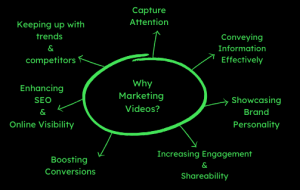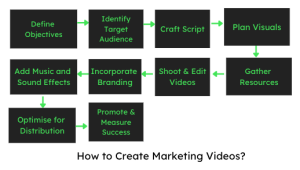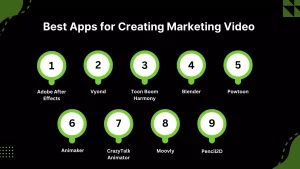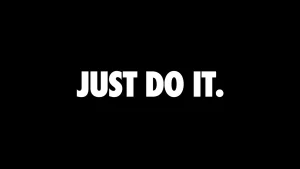Step by Step Guide to Creating a Marketing Video
Did you know YouTube is our country’s largest video platform that claims 55% of its videos consumed in India are from mobile devices (Source)
All businesses need video marketing to stay connected with their audience and keep them engaged.
The popular music brand T-Series started their channel on YouTube that soon reached close to 11 million subscribers. The brand adds 8000 approx subscribers every day. (Source)
This explains the power of marketing videos in the era where platforms are growing with the blink of an eye. Hence businesses need to remain sharp.
Read further to learn how to create marketing videos and understand the positive impact it can have on your business.
What is a marketing video?
A marketing video is a content created to promote a product, service, brand, or message to a target audience. It is a visual and audio medium that utilizes video footage, animation, graphics, and sound to convey information, evoke emotions, and persuade viewers to take a desired action.
Marketing videos are designed to engage viewers, capture their attention, and deliver key messages effectively. They can be used across various platforms, including websites, social media, email campaigns, and presentations.
Marketing videos come in different formats and styles, ranging from explainer videos, product demos, customer testimonials, brand stories, and promotional videos.
These videos are strategically crafted to align with a business or organization’s marketing goals and objectives. They often incorporate storytelling techniques, creative visuals, compelling narratives, and a strong call to action to drive viewer engagement and conversions.
The length of a marketing video can vary depending on the intended platform and purpose. Some videos are short and concise, typically lasting between 15 to 60 seconds, while others may be longer and more in-depth, ranging from a few minutes to even longer formats.
A marketing video is a powerful tool to showcase products or services, communicate brand values, build awareness, generate leads, drive sales, and foster a deeper connection with the target audience. Its goal is to leave a lasting impression, influence viewers’ perceptions, and ultimately contribute to the success of a marketing campaign or overall business objectives.
Why do you need video for marketing purposes?
Marketing videos are essential for several reasons:

- Capturing attention: In today’s fast-paced digital world, grabbing and holding your audience’s attention is crucial. Marketing videos can capture attention quickly through engaging visuals, compelling storytelling, and audio elements, making them effective in standing out amidst the noise of other content.
- Conveying information effectively: Videos combine visual and auditory elements, making it easier to convey information concisely and engagingly. They can effectively showcase product features, demonstrate how-to instructions, or communicate complex concepts more comprehensively than text alone.
- Showcasing brand personality:Marketing videos offer a valuable platform to exhibit the personality and principles of your brand. By utilizing visual storytelling, you have the ability to elicit emotions, establish connections, and create a memorable impact on your viewers. This aids in the development of brand recognition and loyalty.
- Enhancing interaction and shareability: Videos possess a higher likelihood of being shared on social media platforms compared to other forms of content. They generate increased engagement, comments, likes, and shares, thereby extending your reach and exposing your brand to a wider audience.
- Boosting conversions: Marketing videos have been proven to positively impact conversions. They can effectively demonstrate the value of a product or service, highlight customer testimonials, and create a sense of trust and credibility. When used strategically, videos can drive viewers to take action, like purchasing or filling out a form.
- Enhancing SEO and online visibility: Videos can improve your search engine rankings. When properly optimised with relevant keywords, titles, descriptions, and tags, videos can increase online visibility and drive organic traffic to your website or landing pages.
- Keeping up with trends and competitors: Videos have become an increasingly popular and expected form of content consumption. By incorporating marketing videos into your strategy, you can stay relevant, meet customer expectations, and keep up with competitors already utilising video marketing effectively.
Marketing videos are a powerful tool for engaging and connecting with your target audience, conveying your brand message, and driving desired actions. They offer a dynamic and visually appealing way to deliver information, showcase products or services, and boost your business’s success.
Strategy To Create Marketing Videos?
Creating an impactful marketing video requires careful planning and execution. Here is a step-by-step guide to help you through the process:

- Define your objective: Start by clarifying the goal of your marketing video. Are you aiming to increase brand awareness, promote a new product, or drive conversions? Having a clear objective will guide the rest of your creative decisions.
- Identify your target audience: Understand your target audience’s demographics, interests, and pain points. This knowledge will help you tailor your video to resonate with your intended viewers.
- Craft a compelling script: Develop a script that tells a concise and engaging story. Outline key messages, highlight benefits, and include a strong call to action. Keep the script concise and impactful, considering the average viewer’s attention span.
- Plan your visuals: Visuals capture attention and convey your message. Determine the style, tone, and aesthetics that align with your brand and target audience. Storyboard key scenes and shots to ensure a cohesive narrative flow.
- Gather necessary resources: Depending on your script and visual requirements, assemble the resources needed for your video production. This may include actors, props, locations, or stock footage. Ensure you have the right equipment and software for recording and editing.
- Shoot and edit your video: Follow your storyboard and script to shoot the necessary footage. Pay attention to lighting, sound quality, and composition. Once you have captured all the required footage, edit it together, adding transitions, effects, and overlays to enhance the final product.
- Incorporate branding elements: Integrate your logo, colours, and fonts throughout the video. Consistency with your brand identity will strengthen recognition and reinforce your message.
- Add music and sound effects: Select appropriate background music that complements the mood and pace of your video. Enhance the viewing experience by incorporating sound effects where applicable.
- Optimise for distribution: Consider the platform where your video will be shared and optimise it accordingly. Ensure it meets the technical requirements, such as resolution and file format, and consider adding captions or subtitles for accessibility.
- Promote and measure success: Once your video is ready, promote it across relevant channels. Track key metrics such as views, engagement, and conversions to evaluate their effectiveness. Use this data to refine your future video marketing strategies.
Best Apps for Creating Marketing Video

Create marketing videos online free with these videos:
- Adobe After Effects: A powerful industry-standard tool for creating motion graphics and animations with many features and effects.
- Vyond: A user-friendly platform for creating animated videos with pre-built templates and characters, suitable for businesses and educational purposes.
- Toon Boom Harmony: A professional 2D and 3D animation software offering advanced features and flexibility.
- Blender: An open-source 3D animation software that’s versatile and can be used for various types of animations, from simple to complex.
- Powtoon: A web-based platform that allows you to create animated videos and presentations using drag-and-drop elements.
- Animaker: An online tool with various animation styles, characters, and templates, making it suitable for different video needs.
- CrazyTalk Animator: A software that focuses on creating animations with 2D characters, suitable for beginners and professionals.
- Moovly: An online animation tool that offers a library of assets and a simple interface to create engaging animated videos.
- Pencil2D: An open-source software for traditional 2D hand-drawn animation, suitable for artists looking for a digital platform.
- FlipaClip: An app designed for creating animation on smartphones and tablets, useful for simple animations and storyboarding.
Example of Marketing Video
Nike’s marketing videos are known for their inspirational storytelling, visually stunning cinematography, and their ability to connect with viewers on an emotional level. They often feature athletes who embody the brand’s determination, perseverance, and excellence values.
In one memorable marketing video titled “Dream Crazy,” Nike showcased the journey of various athletes who defied expectations and broke barriers in their respective sports. The video highlighted their struggles, triumphs, and unwavering belief in their dreams. It featured famous athletes such as Serena Williams, LeBron James, and Colin Kaepernick, among others, and delivered a powerful message about pushing beyond limits and embracing individuality.

Source: Nike / Dream Crazy
Another example is Nike’s “Just Do It” campaign, featuring numerous marketing videos over the years. These videos inspire viewers to step out of their comfort zones, challenge themselves, and pursue their passions. Whether showcasing everyday people achieving personal goals or elite athletes pushing the boundaries of human potential, Nike’s marketing videos consistently motivate and empower viewers.

Source: Nike, Just Do It
Nike’s marketing videos capture attention, evoke emotions, and effectively communicate the brand’s core values. They create a sense of aspiration and connection, positioning Nike as a brand that supports and celebrates the pursuit of greatness.
These examples demonstrate how Nike has leveraged marketing videos to strengthen its brand identity, engage its target audience, and create a lasting impact. Through their powerful storytelling and visually compelling content, Nike’s marketing videos continue to resonate with viewers and reinforce the brand’s position as a leader in sports and athletic apparel.
Also Read : How Much Does a Marketing Video Cost?
Conclusion
Marketing videos are vital for businesses to engage their audience, convey messages effectively, and drive desired actions. With the power of visual storytelling and compelling narratives, these videos capture attention, evoke emotions, and leave a lasting impact.
Whether showcasing products, sharing brand stories, or inspiring viewers, marketing videos can connect on a deeper level. To create mind-blowing marketing videos for your business, contact us at hello[at]noboruworld.com or book a call.
Let us help you harness the power of video to elevate your brand and captivate your audience. Take advantage of this opportunity to make your mark in video marketing.
FAQ
What is the purpose of a marketing video?
A marketing video promotes a product, service, brand, or message to a target audience. It engages viewers, conveys information, evokes emotions, and ultimately drives desired actions such as conversions or brand recognition.
How long should a marketing video be?
The ideal length of a marketing video varies depending on the platform and audience. Generally, it’s recommended to keep videos between 15 to 60 seconds for social media, while longer videos can be used for website or email campaigns to provide more in-depth information.
What elements make a marketing video effective?
An effective marketing video incorporates compelling storytelling, visually appealing content, a clear message, a strong call to action, and relevance to the target audience. It should engage viewers from the start, maintain their interest, and leave a memorable impression.
How can I measure the success of a marketing video?
Metrics such as views, engagement, click-through rates, conversions, and ROI can be utilized to gauge the effectiveness of a marketing video. By tracking these metrics, one can assess the video’s impact and make informed decisions for future video marketing strategies.
What platforms can I use to distribute my marketing videos?
Marketing videos can be disseminated through various platforms, such as social media channels like Facebook, Instagram, YouTube, and LinkedIn, as well as company websites, email marketing campaigns, and video hosting platforms like Vimeo or Wistia. Media selection should be based on the target audience and marketing objectives.
How can I create a compelling marketing video on a budget?
Creating an effective marketing video on a budget is possible. Consider utilising affordable or free video editing software, leveraging user-generated content, repurposing existing assets, and focusing on strong storytelling rather than costly production. Alternatively, working with a professional video production company can provide expertise and guidance within your budget constraints.



